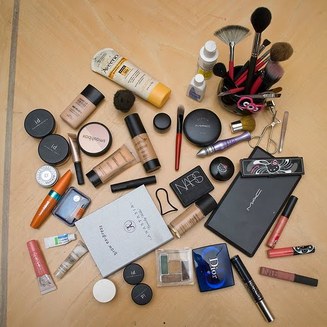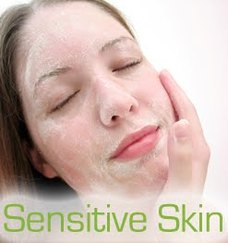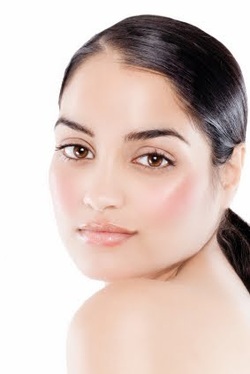COMPLEXION PERFECTION

Carefully
chosen
products
combined
with professional
techniques
give
you a
flawless finish
fast.
The key to successful make-up is getting the base right.This means choosing the right products for your skin type,learning color and application techniques and having a knowledge of quick complexions enhancers for long-lasting polished perfection.
FOUNDATION
This has several beauty benefits:it evens out skin tones,smoothies the skin's texture,provides a base for your other makeup,keeping colors true,and protects your skin.
Choose a color that is close to your own skin-going a few shades lighter or darker or will look unnatural and mask-like.
Tailoring foundation to your skin
Bear in mind your skin type and needs when buying your foundation.It shouldn't look or feel uncomfortable.If it does, it is likely that you have chosen a product incompatible with your skin.
Remember the following when choosing foundation:
* If you have dry skin, look for a creamy, moisturizing formula.
* For oily or combination skin,an oil-free or water based make-up is best as it minimizes shine.
* Hypo-allergenic bases are best if you have a sensitive skin.
* Modern powder and cream mixes in compacts suit most skin types except very dry skin.They are convenient and quick to use, are smoothed on with a sponge, like creamy foundation, and have a silky, powder-like finish.
Application tips
For foundation to look like a second skin,you need to apply it correctly.
Always begin your make-up routine by cleansing and moisturizing your face.Whether you prefer to apply your make-up in day light or artificial light,make sure there are no shadows.It may seem obvious,but if you make-up inadequate or unbalanced lighting,this will cause you precious time later as you try to retouch mistakes.
Dampen a make_up sponge and squeeze it well in a towel so it is just a slightly damp.A triangular wedge shape or a natural sponge is best for applying foundation-they cover more effectively and blend better then fingers.
Using the back of your hand as a palette to mix from, dab dots of foundation on your forehead,cheeks, nose and chin.Work the sponge in quick,downward and outward movements, remembering to blend just under the jaw-line to avoid any tide-marks,but don't take foundations down o
chosen
products
combined
with professional
techniques
give
you a
flawless finish
fast.
The key to successful make-up is getting the base right.This means choosing the right products for your skin type,learning color and application techniques and having a knowledge of quick complexions enhancers for long-lasting polished perfection.
FOUNDATION
This has several beauty benefits:it evens out skin tones,smoothies the skin's texture,provides a base for your other makeup,keeping colors true,and protects your skin.
Choose a color that is close to your own skin-going a few shades lighter or darker or will look unnatural and mask-like.
Tailoring foundation to your skin
Bear in mind your skin type and needs when buying your foundation.It shouldn't look or feel uncomfortable.If it does, it is likely that you have chosen a product incompatible with your skin.
Remember the following when choosing foundation:
* If you have dry skin, look for a creamy, moisturizing formula.
* For oily or combination skin,an oil-free or water based make-up is best as it minimizes shine.
* Hypo-allergenic bases are best if you have a sensitive skin.
* Modern powder and cream mixes in compacts suit most skin types except very dry skin.They are convenient and quick to use, are smoothed on with a sponge, like creamy foundation, and have a silky, powder-like finish.
Application tips
For foundation to look like a second skin,you need to apply it correctly.
Always begin your make-up routine by cleansing and moisturizing your face.Whether you prefer to apply your make-up in day light or artificial light,make sure there are no shadows.It may seem obvious,but if you make-up inadequate or unbalanced lighting,this will cause you precious time later as you try to retouch mistakes.
Dampen a make_up sponge and squeeze it well in a towel so it is just a slightly damp.A triangular wedge shape or a natural sponge is best for applying foundation-they cover more effectively and blend better then fingers.
Using the back of your hand as a palette to mix from, dab dots of foundation on your forehead,cheeks, nose and chin.Work the sponge in quick,downward and outward movements, remembering to blend just under the jaw-line to avoid any tide-marks,but don't take foundations down o
Sensitive Skin

WHAT IS IT?
Sensitive skin can be dry or oily. It's skin which is prone to react adversely to all sorts of external influences. It can be allergic to creams, etc., and can also react to harsh weather, to rough treatment,
and even, in some cases, to simple washing!
HOW TO RECOGNISE ITIt will have the look and feel of dry skin, or oily skin, but it will also show certain recognisable reactions.
Skin is easily irritated . It may come up in red patches, or an overall redness.
Skin may have flaky areas that are dry and very red.
Skin is prone to broken veins.
WHERE MOST COMMON?
All these reactions can be localised-often on the cheeks only, or they can be all over the face and neck.
ALLERGIES
About one in five of us suffer red rashes, swelling and even hot flushes at some times of our lives. Some of us are more prone to allergic reactions than others. It's not really known why we get allergies, but doctors think it could be due to a fault in our immune system. Its job is to ignore friendly intruders into our body, but to identify and attack unfriendly ones.If it's not working properly it sometimes rejects substances which are not actually harmful! The body's defensive white blood cells rush to the site of the
'foreign ' substance - causing the area to become red, itchy and sore.
You may have an instant reaction to an additive in a skin product or makeup, or you may build up resistance over a period of time. So don't be surprised if you experience a reaction to
something you've used successfully for years. Perfume, and the moisturiser, lanolin are two ingredients in skin care which often cause a reaction. If this appears to be quite severe,seek medical help to discover the root cause. There are treatments and drugs which can help.If it's just a slight swelling or redness, you'll probably be able to work out which product has caused it and the best thing to do is to avoid it.
Sensitive skin can be dry or oily. It's skin which is prone to react adversely to all sorts of external influences. It can be allergic to creams, etc., and can also react to harsh weather, to rough treatment,
and even, in some cases, to simple washing!
HOW TO RECOGNISE ITIt will have the look and feel of dry skin, or oily skin, but it will also show certain recognisable reactions.
Skin is easily irritated . It may come up in red patches, or an overall redness.
Skin may have flaky areas that are dry and very red.
Skin is prone to broken veins.
WHERE MOST COMMON?
All these reactions can be localised-often on the cheeks only, or they can be all over the face and neck.
ALLERGIES
About one in five of us suffer red rashes, swelling and even hot flushes at some times of our lives. Some of us are more prone to allergic reactions than others. It's not really known why we get allergies, but doctors think it could be due to a fault in our immune system. Its job is to ignore friendly intruders into our body, but to identify and attack unfriendly ones.If it's not working properly it sometimes rejects substances which are not actually harmful! The body's defensive white blood cells rush to the site of the
'foreign ' substance - causing the area to become red, itchy and sore.
You may have an instant reaction to an additive in a skin product or makeup, or you may build up resistance over a period of time. So don't be surprised if you experience a reaction to
something you've used successfully for years. Perfume, and the moisturiser, lanolin are two ingredients in skin care which often cause a reaction. If this appears to be quite severe,seek medical help to discover the root cause. There are treatments and drugs which can help.If it's just a slight swelling or redness, you'll probably be able to work out which product has caused it and the best thing to do is to avoid it.

WHAT IS IT?
Skin of any age can have an oiliness problem, though it usually lessens as we get older. Here, the sebaceous glands produce too much sebum. The most common cause is a change in hormone levels, hence the spots, pimples and acne that young people suffer when they reach puberty. For older people it can have its advantages, since those who've always had an oily skin are less prone to wrinkles as they age.
HOW TO RECOGNISE IT
Skin feels greasy on the surface . Wipe with a tissue and you'll see the oil .
Skin looks shiny because of a film of oil on the surface.
Skin is prone to spots, pimples and blackheads- pores blocked with sebums, or oil.
Skin may have acne - bad patches of spots and pimples which are red and raised and may contain yellow pus.
Skin may be sensitive- oily skin is not necessarily 'tougher' than dry- and need careful handling.
Skin may suffer allergic reactions to certain products. These may show up as redness or a patchy rash.
WHERE MOST COMMON?
Centre of forehead, between the eyes, the nose, around the sides of the nose and chin. There are more sebaceous glands in these areas than elsewhere on the face. On the body, oily skin most often occurs on the chest and back.
Skin of any age can have an oiliness problem, though it usually lessens as we get older. Here, the sebaceous glands produce too much sebum. The most common cause is a change in hormone levels, hence the spots, pimples and acne that young people suffer when they reach puberty. For older people it can have its advantages, since those who've always had an oily skin are less prone to wrinkles as they age.
HOW TO RECOGNISE IT
Skin feels greasy on the surface . Wipe with a tissue and you'll see the oil .
Skin looks shiny because of a film of oil on the surface.
Skin is prone to spots, pimples and blackheads- pores blocked with sebums, or oil.
Skin may have acne - bad patches of spots and pimples which are red and raised and may contain yellow pus.
Skin may be sensitive- oily skin is not necessarily 'tougher' than dry- and need careful handling.
Skin may suffer allergic reactions to certain products. These may show up as redness or a patchy rash.
WHERE MOST COMMON?
Centre of forehead, between the eyes, the nose, around the sides of the nose and chin. There are more sebaceous glands in these areas than elsewhere on the face. On the body, oily skin most often occurs on the chest and back.

WHAT IS IT?
Within our skin lie thousands of sebaceous glands.It's their job to produce oil to lubricate the skin.The fine film of oil on the surface of our faces 'seal' in the normal moisture content of the skin,keeping it supple.If not enough oil is produced,however,the skin's water is able to evaporate-leaving our faces feeling dehydrated and dry.
Wind,central heating and air conditioning, etc., can overpower the skin's oily defence system-speeding up moisture loss and making the skin feel dry . Frequent washing, especially with harsh soap , can strip away the natural oil, making it easier for the skin's water content to escape through evaporation!
HOW TO RECOGNISE IT
Skin feels tight, not firm but taut, especially after being outdoors or in a drying atmosphere.
Skin may flake. Extremely dry skin can lose its top layer- in the same way as your nose does after you've had a cold. (Even a usually oily area such as the nose can become dry by losing moisture from the surface of the skin- it's the moisture that makes the difference, not the oil!)
Skin tends to look dull, and can have a crepy appearance .
Skin is more prone to lines and crow's feet.
Skin is sensitive, and prone to broken veins. These range from occasional tiny broken capillaries-looking like minute strikes of red lighting - to vividly rosy cheeks which are a mass of broken veins. The veins lie just beneath the surface of the skin, and the rupturing is often caused by extremes of temperature or weather ; hot water ; a blow, or heavy pressure, such as trying to squeeze a spot ; or by eating very heavily spiced or hot food ; or drinking alcohol. All these cause blood to flush to the surface of the skin where it then cools quickly .
WHERE MOST COMMON?
Throat, cheeks, either side of forehead -there are fewer sebaceous glands in these areas . Though, of course, any area can become dry through harsh conditions or treatments.
Within our skin lie thousands of sebaceous glands.It's their job to produce oil to lubricate the skin.The fine film of oil on the surface of our faces 'seal' in the normal moisture content of the skin,keeping it supple.If not enough oil is produced,however,the skin's water is able to evaporate-leaving our faces feeling dehydrated and dry.
Wind,central heating and air conditioning, etc., can overpower the skin's oily defence system-speeding up moisture loss and making the skin feel dry . Frequent washing, especially with harsh soap , can strip away the natural oil, making it easier for the skin's water content to escape through evaporation!
HOW TO RECOGNISE IT
Skin feels tight, not firm but taut, especially after being outdoors or in a drying atmosphere.
Skin may flake. Extremely dry skin can lose its top layer- in the same way as your nose does after you've had a cold. (Even a usually oily area such as the nose can become dry by losing moisture from the surface of the skin- it's the moisture that makes the difference, not the oil!)
Skin tends to look dull, and can have a crepy appearance .
Skin is more prone to lines and crow's feet.
Skin is sensitive, and prone to broken veins. These range from occasional tiny broken capillaries-looking like minute strikes of red lighting - to vividly rosy cheeks which are a mass of broken veins. The veins lie just beneath the surface of the skin, and the rupturing is often caused by extremes of temperature or weather ; hot water ; a blow, or heavy pressure, such as trying to squeeze a spot ; or by eating very heavily spiced or hot food ; or drinking alcohol. All these cause blood to flush to the surface of the skin where it then cools quickly .
WHERE MOST COMMON?
Throat, cheeks, either side of forehead -there are fewer sebaceous glands in these areas . Though, of course, any area can become dry through harsh conditions or treatments.

